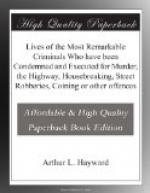His waistcoat, and stockings,
and breeches were white;
His cap had a new cherry ribbon
to tie’t.
The maids to the doors and
the balconies ran,
And said, “Lack-a-day,
he’s a proper young man!”
But as from the windows the
ladies he spied,
Like a beau in a box, he bow’d
low on each side.
Execution day, or Tyburn Fair, as it was jocularly called, was not only a holiday for the ragamuffins and idlers of London; folk of all classes made their way thither to indulge a morbid desire of seeing the dying agonies of a fellow being, criminal or not. There were grand stands and scaffoldings from which the more favoured could view the proceedings in comfort, and every inch of window space and room on the neighbouring roofs was worth a pretty penny to the owners. In his last scene of the career of the Idle Apprentice Hogarth drew a picture of Tyburn Tree which no description can amplify.
As the procession drew near the hangman clambered to the cross-piece of the gallows and lolled there, pipe in mouth, until the first cart drew up beneath him. Then he would reach down, or one of his assistants would pass up, one after the other, the loose ends of the halters which the condemned men had had placed round their necks before leaving Newgate. When all were made fast Jack Ketch climbed down and kicked his heels until the sheriff, or maybe the felons themselves, gave him the sign to drive away the cart and leave its occupants dangling in mid-air. The dead men’s clothes were his perquisite, and now was his time to claim them. There is a graphic description of how, on one occasion, when the murderer “flung down his handkerchief for the signal for the cart to move on, Jack Ketch, instead of instantly whipping on the horse, jumped on the other side of him to snatch up the handkerchief, lest he should lose his rights. He then returned to the head of the cart and jehu’d him out of the world”.
As the cart drew away a few
carrier pigeons, which were released
from the galleries, flew off
City-ward to bear the tidings to
Newgate.
Perhaps as good a description of the actual event as can be obtained is contained in a letter from Anthony Storer to his friend George Selwyn, a morbid cynic whose cruel and tasteless bon-mots were hailed as wit by Horace Walpole and his cronies. The execution was that of Dr. Dodd, the “macaroni parson”, whose unfortunate vanity led him to forgery and Tyburn. The date—June 27, 1777—is considerably after the period of our book, but the description applies as well as if it had been written expressly for it.




